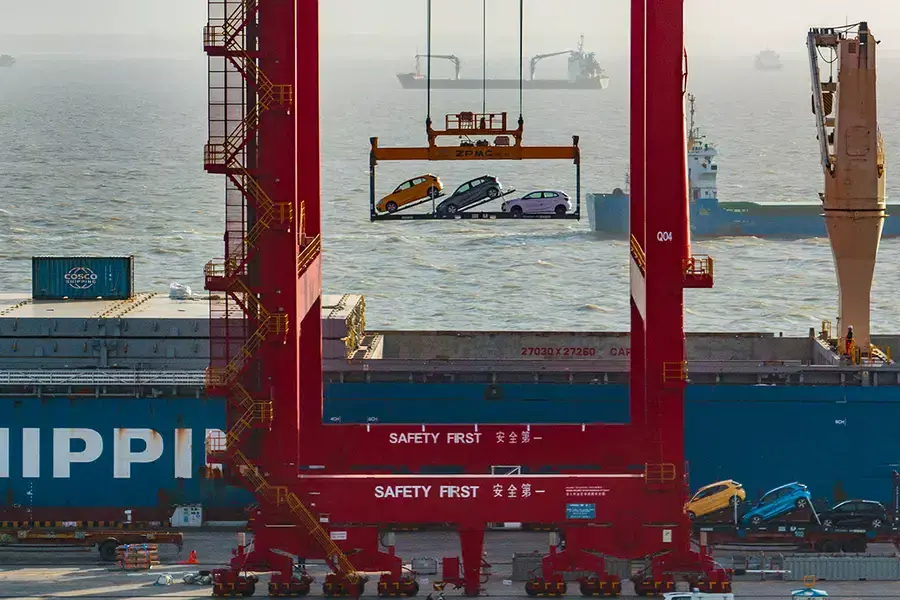The President’s Inbox Recap: A Second China Shock

The latest episode of The President’s Inbox is live! This week, Jim sat down with Brad Setser, the Whitney Shepardson senior fellow at the Council, to discuss the causes and consequences of China’s recent export surge.
A Second China Shock, With Brad Setser
Brad Setser, the Whitney Shepardson senior fellow at CFR, sits down with James M. Lindsay to discuss the causes and consequences of China’s export surge.
Here are five highlights from their conversation:
1.) The surge in Chinese exports in the early 2000s was thought to be a one-off. China’s exports surged after it entered the World Trade Organization. Lower-cost goods benefited consumers in the United States and suppressed inflation. But those benefits came at a cost. As Brad put it, “the surge in U.S. imports from China, Chinese exports to the U.S., likely led to the reduction of about a million manufacturing jobs, and then another million jobs in those manufacturing-centric communities.” By the 2010s, most economists thought that the so-called China shock was a thing of the past. Chinese labor costs had risen, the Chinese currency had appreciated, and policy in the United States and elsewhere had adjusted. As economists like to say, an equilibrium had been restored.
More on:
2.) The world is now facing a second China shock. China has responded to its slowing economic growth—triggered first by Covid-19 and then by a burst in its real estate market—by doubling down on what fueled its meteoric economic rise: exports. Beijing is subsidizing domestic manufacturers, who are producing more than China’s domestic market can use. The surplus is going overseas. Producers across the globe are feeling the pinch created by the flood of cheaper, state-subsidized Chinese goods. Countries—and not just the United States—are looking to slow imports from China to save their domestic industries.
3.) China has other options to stimulate economic growth besides sending more goods abroad. Economists inside and outside of China have long urged Beijing to balance its economy by encouraging domestic consumption. Xi Jinping has refused to take that advice. Brad noted “that's part of the reason why COVID played out differently in different parts of the world. We [the United States] supported households, China supported its firms, China recovered from exports, we recovered on the back of strong household spending.” China’s decision to favor exports over domestic demand also reflects the difficulty in getting Chinese citizens to spend more. China lacks a significant social safety net. As a result, Chinese citizens save rather than spend so that they have sufficient funds to support themselves and their family in the face of illness or old age.
4.) Curtailing Chinese exports comes at a potentially expensive price. It’s easy to see why countries have sought to limit surging Chinese exports. They can put domestic firms out of business and cost voters their jobs. However, most countries are also committed to speeding up a green energy transition to avoid the potentially existential threat of climate change. The problem is, many of the lower-cost goods China is exporting are the very things countries need to reduce their carbon footprint. Think electric vehicles, solar panels, and wind turbines. As Brad said, “if you want to accelerate the transition away from an oil-powered auto fleet, Chinese [electric vehicle] capacity is the easiest, cheapest way to do it.” But the most efficient course of action might not be the politically wisest course of action. He said, “certainly, it's the view of the Biden administration that in order for the green transition to be politically sustainable, it has to be tied to local manufacturing jobs.”
5.) The U.S. response should be a mix of policies. Brad suggested that one way for the United States to respond to Chinese exports is to become more competitive. The Inflation Reduction Act and the CHIPS Act are efforts to do just that. Another option is to impose tariffs. But tariffs lessen the incentive for domestic firms to adjust, and China has various strategies to evade them. Building a stronger trading bloc in North America like a North American Free Trade Agreement (NAFTA) 2.0 could make it more difficult for China to enter the North American market.
If you’re looking to read more of Brad’s analysis on the second China shock, check out the piece he co-wrote for his blog Follow the Money titled “China’s Record Manufacturing Surplus.”
More on:
 Online Store
Online Store
